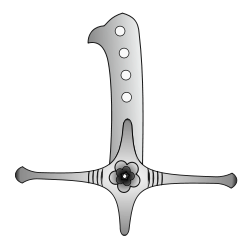
Karabela
Encyclopedia

Szabla
Szabla is the Polish word for sabre. It specifically refers to an Eastern European one-edged sabre-like mêlée weapon with a curved blade and, in most cases, a two-bladed tip called a feather . Initially used by light cavalry, with time it also evolved into a variety of arms used both for martial...
(szabla). Perhaps one of the most famous types of that type of weapons, it became highly popular in the Polish-Lithuanian Commonwealth
Polish-Lithuanian Commonwealth
The Polish–Lithuanian Commonwealth was a dualistic state of Poland and Lithuania ruled by a common monarch. It was the largest and one of the most populous countries of 16th- and 17th‑century Europe with some and a multi-ethnic population of 11 million at its peak in the early 17th century...
in the 1670s. Most likely the name was coined after the Turkish
Turkish language
Turkish is a language spoken as a native language by over 83 million people worldwide, making it the most commonly spoken of the Turkic languages. Its speakers are located predominantly in Turkey and Northern Cyprus with smaller groups in Iraq, Greece, Bulgaria, the Republic of Macedonia, Kosovo,...
terms Kara (dark,black,big) and belâ (بلاء from Arabic: immense hardship).
The sabre was modelled after the swords of the Turkish
Ottoman Empire
The Ottoman EmpireIt was usually referred to as the "Ottoman Empire", the "Turkish Empire", the "Ottoman Caliphate" or more commonly "Turkey" by its contemporaries...
footmen formations of Janissaries and Spahis, which used it in close quarters. Much lighter than the hussar szabla, the karabela had an open hilt
Hilt
The hilt of a sword is its handle, consisting of a guard,grip and pommel. The guard may contain a crossguard or quillons. A ricasso may also be present, but this is rarely the case...
with the pommel
Pommel
Pommel may refer to:* pommel, the raised area at the front of an equestrian saddle.* Pommel, the counterweight at the end of the hilt of a European sword* Pommel horse, an artistic gymnastics apparatus...
modelled after an eagle
Eagle
Eagles are members of the bird family Accipitridae, and belong to several genera which are not necessarily closely related to each other. Most of the more than 60 species occur in Eurasia and Africa. Outside this area, just two species can be found in the United States and Canada, nine more in...
's head. Such a grip allowed for easier handling of circular cuts while fighting on foot, and for swinging cuts from horseback.
Initially, the karabela sabres were used mostly for decoration or as a ceremonial weapon worn on special occasions. Popularized during the reign of King Jan III Sobieski, the sabre became one of the most popular Polish melee
Mêlée
Melee , generally refers to disorganized close combat involving a group of fighters. A melee ensues when groups become locked together in combat with no regard to group tactics or fighting as an organized unit; each participant fights as an individual....
weapons. Though in theory the type could be subdivided into ornamental ceremonial type and a simple battle weapon, in reality both more expensive and the cheaper designs were often used in combat. Most of the Polish nobility (szlachta
Szlachta
The szlachta was a legally privileged noble class with origins in the Kingdom of Poland. It gained considerable institutional privileges during the 1333-1370 reign of Casimir the Great. In 1413, following a series of tentative personal unions between the Grand Duchy of Lithuania and the Kingdom of...
) could afford only one expensive karabela and, in case of need, simply replaced the ebony
Ebony
Ebony is a dense black wood, most commonly yielded by several species in the genus Diospyros, but ebony may also refer to other heavy, black woods from unrelated species. Ebony is dense enough to sink in water. Its fine texture, and very smooth finish when polished, make it valuable as an...
or ivory
Ivory
Ivory is a term for dentine, which constitutes the bulk of the teeth and tusks of animals, when used as a material for art or manufacturing. Ivory has been important since ancient times for making a range of items, from ivory carvings to false teeth, fans, dominoes, joint tubes, piano keys and...
-made scabbard
Scabbard
A scabbard is a sheath for holding a sword, knife, or other large blade. Scabbards have been made of many materials over the millennia, including leather, wood, and metals such as brass or steel.-Types of scabbards:...
with a leather-made one, and removed some of the precious stones from the hilt in order to convert it into a fully reliable weapon.
In Turkish, Karabela could be understood as "Black Misfortune", from the Turkish "Kara" meaning black and the Arabic "Bela" meaning misfortune, calamity, trial, curse.

